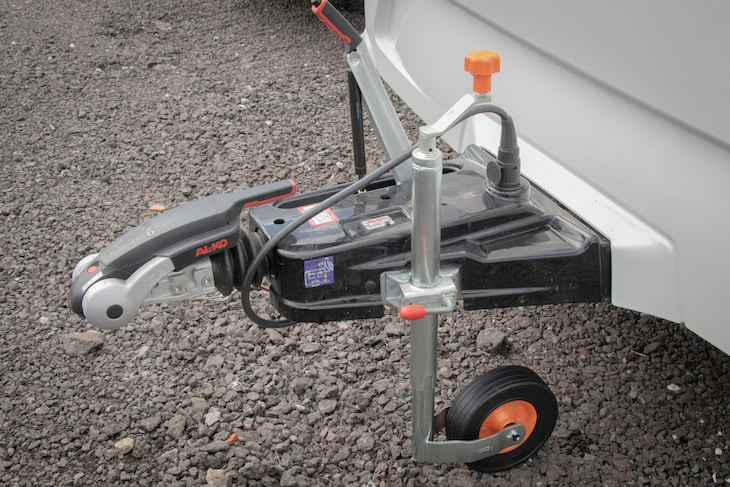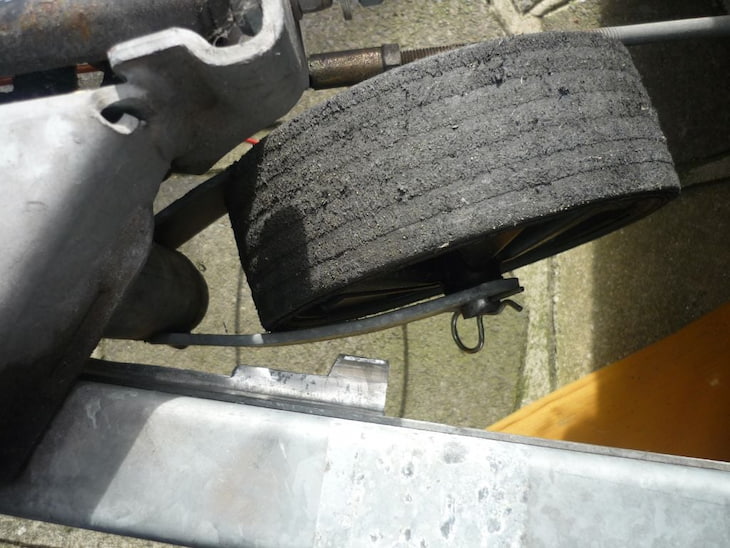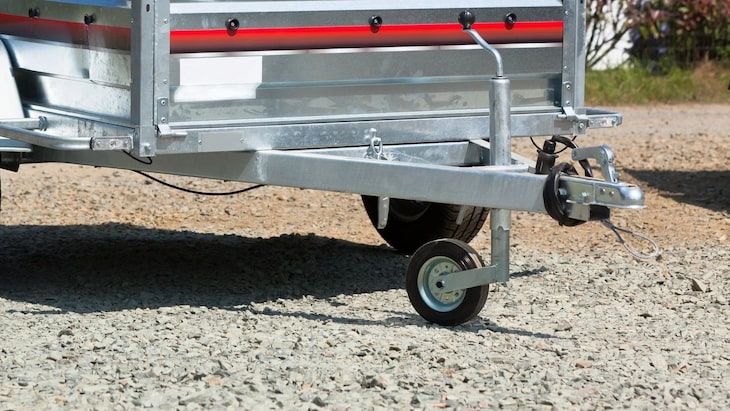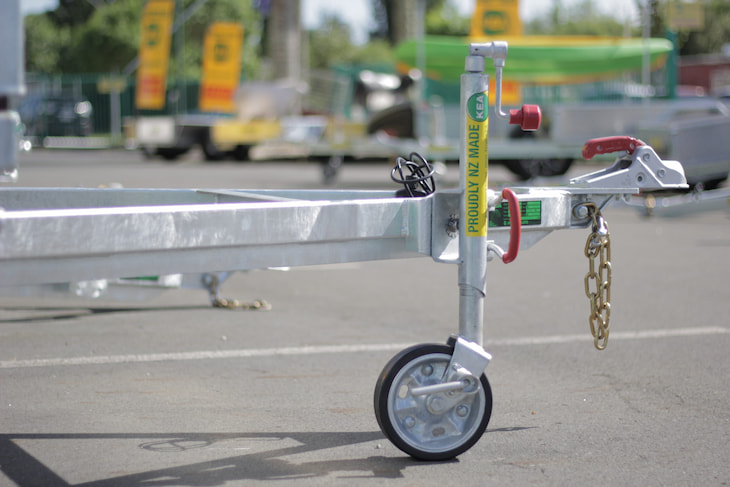08
Mar

If you own a caravan and trailer, you already know that you’ll eventually have to change your jockey wheel or trailer stand. It’s one of the most crucial accessories you can equip your home on wheels with because it’s to do with both safety and function.
Hard knocks, ground strikes, and heavy loads are only a few of the unintended encounters that can leave you with a jockey wheel that won’t retract, pivot, or render it too weak to continue supporting your trailer. Even years of built up grime and debris inside the assembly’s sleeve can leave you with a stand that behaves as if it’s been welded together.
Suffice it to say, if you can’t fully raise or lower your jockey wheel, or if your tyre has cracked or flattened out from being dragged, you need to contemplate investing in a new assembly. It’s an easily performed upgrade that’s not expensive, and it’s going to make a big difference whenever you’re moving your trailer.

Let’s be honest: whether it’s in your driveway or at a campsite, there’s nothing pleasant about wrestling with a damaged or nuisance jockey wheel or trailer stand. The likelihood of property damage and personal injury becomes too great after a certain point, which is why you urgently need to prioritize replacing jockey wheels as soon as they become exceedingly troublesome.
For campers, caravans, or any other types of specialty trailers, new, high quality jockey wheels and trailer stands are going to give you back the core abilities of being able to:
· Successfully level your caravan or trailer at campsites and on uneven ground;
· Effortlessly manoeuvre your trailer when it’s not hitched to a tow vehicle; and,
· Efficiently tilt boat- or roll-on trailers when they’re being loaded or unloaded.
Most importantly though, having a properly functioning jockey wheel on your trailer eliminates the risk of avoidable physical injury, while also keeping your trailer and its contents out of jeopardy. It’s the logical alternative to continuing to struggle with an old, faulty, or insufficiently rated assembly, and waiting too long to replace it can quickly become more problematic than it’s worth.

Regardless of why you need to replace the assembly that’s currently on your trailer, you can buy jockey wheels and trailer stands in three main mounting types:
· Fixed mounts. Fixed mounted wheels and stands are adjusted simply by raising or lowering the assembly’s wheel or base plate and are sufficient for most ordinary trailer uses.
· Swivel mounts. Swivel mounted wheels and stands feature a release handle that allows the assembly to rotate and stow away securely into a horizontal position along the trailer’s drawbar.
· Clamp mounts. Clamp mounted wheels and stands consist of a sleeve that can be clamped onto the trailer’s drawbar from three different points, and are completely removeable when not in use to prevent theft or tampering.
When you’re looking at the different types, you want to be sure that the one you choose is compatible with your trailering needs. There’s nothing wrong with wanting to replace a lightweight, malfunctioning factory assembly with a good looking swivel mount, but bear in mind that with more moving parts, there are also more possible points of failure.
Length is also an important aspect of choosing the right type, especially if your current assembly was prone to being bumped into. With the length of most jockey wheels for sale ranging between 150 – 250mm, the ideal type is going to be one that doesn’t expose itself to extension stress or impact damage, but can still meet your hitch height.
The thickness of your replacement jockey wheel’s sleeve is another point that needs to be assessed carefully. The best way to accomplish this though, is by evaluating the thickness of the assembly you’re replacing, and by gauging whether a change in thickness would have increased its survivability.

There are four main jockey wheel sleeve thicknesses:
· 35mm. These are for extra lightweight service like box, off road, and uni style trailers.
· 42mm. These are for lightweight, and some unbraked trailers like luggage and tandems styles.
· 48mm. These are for larger service units like caravans and boat trailers.
· 60mm. These are for the heaviest duty trailers with static weights in excess of 750kg.
Size matters when you buy jockey wheel and wheel stand assemblies. Assemblies with thicker sleeves are capable of supporting heavier static weights, and can withstand the kinds of impacts and rough jockeying that the assembly you’re replacing may have experienced.
When it comes to static weight ratings, you can expect new heavy duty jockey wheels and trailer stands to vary between 350kg – 750kg. This is sufficient for most caravans, pantechs, and open type trailers, but you’ll need to estimate the weight of your trailer’s contents to determine what the optimum weight rating for your jockey wheel assembly would be.
For safety, the new assembly’s static weight rating should exceed the total amount of the weight you’re trailering by 20%. This is a valuable precautionary parameter to keep in mind, especially if your old assembly was damaged because it couldn’t support the weight. Never having to worry about whether you’ll be able to raise your trailer after an under-rated jockey wheel collapses begins here.

Getting the right type and diameter of tyre is the final part of choosing a proper replacement assembly. This is especially important because when it comes to jockey wheels Australia can subject tyres to a range of conditions that aren’t found anywhere else. If the tyre you’re replacing was showing vulnerability to changes in terrain and temperature, you want to have a type with your replacement that’s more suitable for your trailering environment. There are two types of jockey wheel tyres:
· Solid. Solid tyres can be made from rubber, nylon, or plastic, and are ideal for use on solid surfaces like concrete or packed ground.
· Pneumatic. Pneumatic tyres are air filled and can be used anywhere, but they’re best suited for loose surfaces like sand or soft ground.
And when it comes to jockey wheel diameters, most tyres tend to reside between 150 – 250mm. Ultimately, you also want to be sure that the diameter of the replacement tyre is appropriate for the size and weight of trailer it needs to support.
Don’t put off replacing jockey wheels until it’s too late. A new, high quality jockey wheel or trailer stand is going to give you the peace of mind you need when you’re jockeying or towing your trailer.
At the end of the day, there’s no shortage of reasons that you may have for needing to replace a jockey wheel or trailer stand. What’s crucial, however, is getting it replaced before that reason goes from being a minor inconvenience to a major headache.